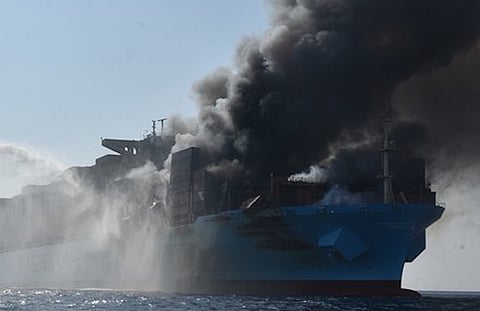

It is both good news and a recognition of a long-felt need that a powerful consortium of technical expertise is being put to work to address the worrying problem of fires in containers. There is, apparently, a serious conflagration in a container about every five weeks while there are fires that are easier to extinguish on a more frequent basis. So, there is some enthusiasm that the European Maritime Safety Agency, the Danish Institute of Fire and Security Technology, along with the considerable muscle of Bureau Veritas and the support of the Research Institute of Sweden and the University of Southern Denmark are collaborating to deliver a Formal Safety Assessment Study on containership fires. It will be completed by the beginning of February next year, so they are moving fast.
It seems that this vexed subject has been on the agenda for decades, without seemingly much progress, while the scale of the problem has grown exponentially along with the size of container ships. I attended a seminar held by one of the classification societies at least twenty years ago, when there seemed to be an almost fatalistic attitude exhibited by some of the participants, notably those representing the sea carriers. Since then, there has been some progress, notably in the shape of clamping down on the failure to declare dangerous goods and even more recently, with some brave carriers even fining those who take their obligations lightly as regards declarations.
But there has been no great technical breakthrough that enables pitifully small ships' crews to tackle fires, while the number of boxes at risk in a single ship has hugely increased. Insurers, P&I clubs and salvors, along with fire safety experts, have periodically expressed their concern, but the fires continue, with everyone, it seems, just hoping that the odds will remain on their side in a percentage game.
To someone brought up in pre-container days, with cargo care beaten into our skulls by our senior officers, there has always been something about sealed steel boxes that defies common sense. Who recalls, for instance, the strict injunctions stencilled on packing cases to "stow away from boilers". It is perhaps a redundant instruction these days, if you think of the heat that can be built up in a steel container, whether it is deep in a hold or perched on the top of the stack under the blazing tropical sun. When I recall the efforts we made with fans and ventilation and fanatical attention to the temperatures and dew point, it is obvious that outside the reefer trades, cargo has to just sweat it out.
Then with the explosion in ship sizes, we have seen the huge globalisation in the production of goods that never were traded in great quantities until the advent of cheap container shipping. It is not surprising that fires break out with some regularity in cargoes of cheaply manufactured and badly packed basic chemicals or stuff like charcoal, which is notorious for overheating. Maybe the recent sudden spike in shipping costs, allegedly making people think afresh about the need to ship this rubbish over thousands of miles from the other side of the earth, will have an effect on the incidence of fires. But already rates are falling from their unprecedented peaks, so good intentions may be forgotten.
You have to hope that punitive sanctions on rogue shippers, better targeting of problematical cargo, along with greater vigilance might start to have an effect on the container fire statistics. The EMSA- BV consortium will address not just prevention, but fire detection, alarm systems, containment, and firefighting, and they will be including in their remit equipment suppliers, designers shipping companies and flag states that have experience to offer. In recent times, notably after the appalling Maersk Honam disaster, there were ideas proposed by salvors, for designers to consider the installation of fireproof barriers between deck stacks, at least around hazardous cargoes, but this has yet to be accepted by anyone. There still seems few practical solutions other than crews having to take fearsome risks pushing lances through the sides of burning boxes.
It is also worth noting the risks that ports are running with their need to keep large numbers of boxes safe while in their custody. There was a nasty reminder last year when a box being transshipped exploded shortly after it had been loaded on a feeder ship. The inquiry discovered that the box with its chemical contents had been "cooking" on the quay in the Gulf port for the best part of a fortnight, having been landed by the ocean carrier.
The FSA study on containership fires will have no shortage of topics as its work progresses.
